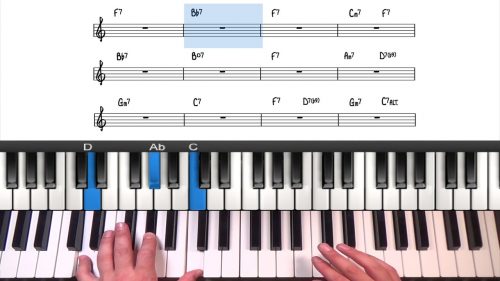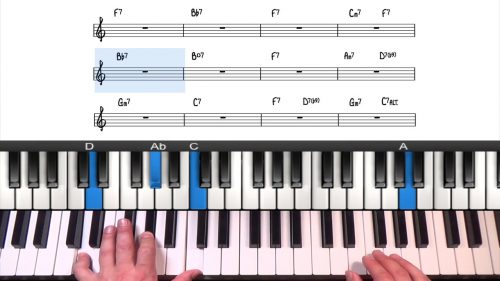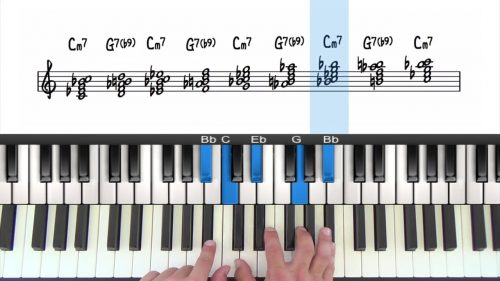Approach Patterns & Target Notes
In this lesson we look at the tune ‘Alone Together’ to demonstrate some important improvisational concepts.
The concepts we’ll be focusing on are target notes, approach patterns and chromaticism. Understanding these principles will add structure to your lines and will help you solos sound more interesting and professional.
Alone Together was originally written as a ballad but we’re going to play the tune at a medium tempo of around 120bpm.
The tune itself contains a lot of altered harmony with 251s in a number of minor keys. We’re going to focus on building lines containing altered tones, which then resolve into more consonant and stable-sounding chord tones.
I’ll start of by playing through the form with a mixture of left hand voicings and 2 handed voicings and then we’ll jump straight into improvising over the chord changes.
Lesson Downloads
-
“Alone Together” Improvisation File Type: pdf
Practice Tips
-
Always always always have a point in mind where you will resolve you line. This will stop you wandering up and down scales with little direction.
-
Chromaticism is you best friend when improvising. It can get you out of some really tight spaces and make your lines sound more professional.
-
Use chromaticism to target primary chord tones or extensions.
-
Try adding enclosures to your lines. An enclosure is where you play the tones on either side of the target tone.
-
Look out for parrallel movement and repetition in the chord changes. For example, over back-to-back 25s or 251s, you can play the same idea over each - just transpose it into the new key.
-
Try to tell a narrative. Focus on less ideas but really develop those ideas to their fullest potential.
- Bad solos are usually characterised by lots of ideas with very little cohesion betweem them. Try to tie your solo together by repeating similar phrases and motifs.






I’m so impressed with this “Alone Together” improvisation, I even joined Disqus. I’m going through the transcription using Transcribe. I’m only on the “A” section so far, but I absolutely love this! There’s so much useful material here, like the block chord jump in minor thirds in measure 15; the Kenny Barron voicing from Gm7 to C7b9#ll in measure 25; the passing chord in measure 27; the use of neighboring tones in measure 28 – just fantastic!. I can hardly wait for the “Blue In Green” transcription to be finished. Thanks Hayden!
Glad you enjoyed the lesson Walt! I actually have a lot more improvisation pointers to share with this tune so I will have to make a Part 2 (It was getting a little long at 40 minutes!)
All of the minor 25s and 251s make it a great tune for applying blues and altered harmony…. I’ll get a followup tutorial done in the next few weeks. Cheers, Hayden
I agree totally with the previous comments and like that we are now learning the basics of improvisation. Love bars 67 and 68 where tha lick is stated and then repeated. Look forward to part 2 and thanks for a great arrangement.
Excellent!! Well done presentation with time and thought out mapped approach to improvisation. This is what improv is all about and your methodic presentation was the best jazz school or conservatory any jazz musician will enjoy to study. Thank you for being here with us and making a tutorial of this kind and time length is excellent to present what you have presented here for us. I loved it ,loved it. THANKS!!
Thanks George!
Hayden I revisited this lesson and I had to comment how excellent this presentation was put together on improvisation .Very well done and much food for thought. I can’t thank you enough for this one. Fabulous.
Hi George, thanks very much I appreciate the feedback. There are more improv tutorials coming shortly… the first one i published earlier on swing feel: https://www.pianogroove.com/jazz-piano-lessons/play-swing-rhythm/ – it has some major 251 lines that you may find useful. Cheers, Hayden
It appears the play back speed control is missing from this tutorial. I’ve reloaded the page and still don’t see it.
Love the site and all the hard work! Keep it up!
Hi Seth,
Thanks for letting me know about this – I have added the speed controls and A/B Loop.
Glad to hear you are enjoying the site.
Stay safe and enjoy the lessons!
Cheers, Hayden
Excellent lesson. There are a lot of pearls. How should an improv be related to the original melody and not just the chord structure?
Hi Edwin,
I’m glad you enjoyed the lesson!
That’s a great question….
There are many ways that we could relate our improvisations to the actual melody.
We can take the motifs from the melody and play them over other chord changes in the tune. Here’s a video of me performing “There Will Never be Another You” with Lyndol, and notice at 2:00s during my improvisation that I quote the ascending motif from melody and repeat this 3 times before moving on to other improvised ideas: https://www.pianogroove.com/community/t/course-demonstration-by-lyndol-hayden/1995
Here I am taking the rhythmic aspect of the melody, and superimposing it over multiple chord changes which is fun to do.
We could also take a melody line and add notes into it, or perhaps take notes away, or even use the melody as a starting point to develop your own ideas.
My best piece of advice is to listen to lots of versions of this song, and try to work out the improvised lines with your ears. If you are new to transcription check out the ear training section in the forum: pianogroove.com/community/c/improvisation-exercises/30
I hope that helps Edwin and let me know if you have any further questions.
Cheers, Hayden
Absolutely brilliant class! thanks Hayden!